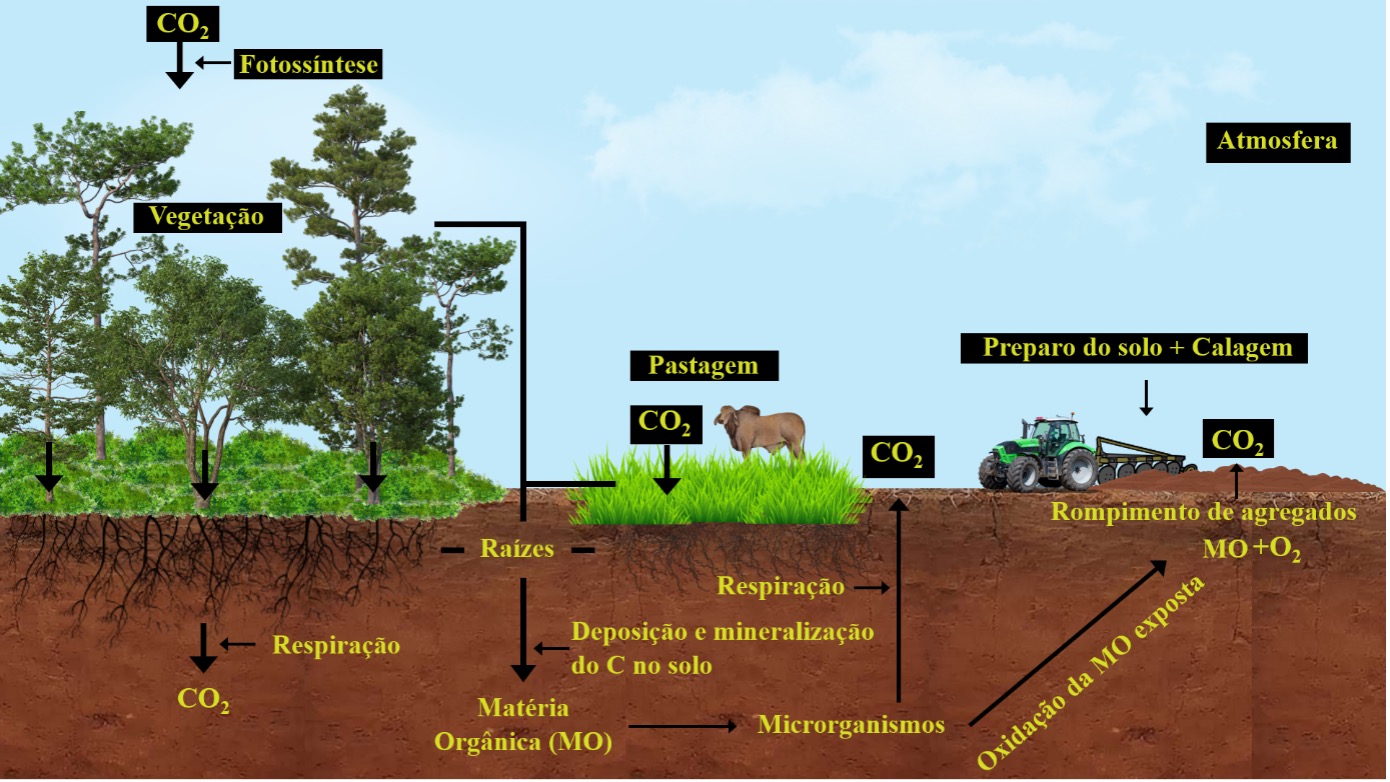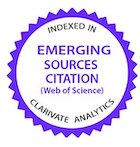Mudanças de uso da terra e emissão de gases de efeito estufa: uma explanação sobre os principais drivers de emissão
DOI:
https://doi.org/10.1590/1809-6891v25e-77646EResumo
O aquecimento global é atribuído ao aumento das emissões de gases de efeito estufa (GEE), como dióxido de carbono (CO2), metano (CH4) e óxido nitroso (N2O). As mudanças no uso da terra têm impactos significativos nas emissões de GEE, sendo responsáveis por aproximadamente 44% das emissões do país em 2019. Essa é uma revisão que aborda as principais rotas de formação dos GEE no solo com foco na influência das mudanças do uso da terra nas emissões de GEE. Constata-se que as emissões de CO2 pelo solo estão relacionadas à respiração de raízes, microrganismos e decomposição da matéria orgânica (MO) do solo, assim mudanças no uso da terra podem alterar as características do solo, favorecendo a intensificação das emissões de CO2. As emissões de CH4 pelo solo ocorrem em condições de anaerobiose por microrganismos metanogênicos, no entanto as mudanças no uso da terra, como a conversão de florestas em pastagens, podem aumentar as emissões de CH4 devido a uma maior concentração de microrganismos metanogênicos no solo. Já o N2O é produzido no solo durante o processo de nitrificação e desnitrificação por microrganismos, e a fertilização nitrogenada em áreas agrícolas pode aumentar as emissões de N2O, especialmente quando associada à umidade e disponibilidade de carbono orgânico no solo. Destaca-se a importância de compreender as dinâmicas de formação e emissão de GEE decorrentes das mudanças de uso da terra, pois estratégias eficientes de manejo podem reduzir essas emissões e contribuir para o cumprimento das metas do Brasil em relação à redução de GEE estabelecidas em acordos internacionais.
Downloads
Referências
IPCC. Resumo para formuladores de políticas. In: Mudança Climática e Terra: um relatório especial do IPCC sobre mudança climática, desertificação, degradação da terra, gestão sustentável da terra, segurança alimentar e fluxos de gases de efeito estufa em ecossistemas terrestres. 2019. 41p.
Eggleston HS, Buendia L, Mika K, Ngara T, Tanake K. IPCC guidelines for national greenhouse gas inventories. Hayama: IGES, 2006. https://www.ipcc.ch/report/2006-ipcc-guidelines-for-national-greenhouse-gas-inventories/
Sistema De Estimativa De Emissões De Gases De Efeito Estufa – SEEG. SEEG Brasil. Emissões totais série histórica. Disponível em: <http://plataforma.seeg.eco.br/total_emission#> Acesso em 15/05/2021.
Moges A, Dagnachew M, Yimer F. Land Use Effects on Soil Quality Indicators: A Case Study of Abo-Wonsho Southern Ethiopia. Applied and Environmental Soil Science. 2013, 2013:784989. https://doi.org/10.1155/2013/784989
Kroeger ME, Delmont TO, Eren AM, Meyer KM, Guo J, Khan K, Rodrigues JLM, Bohannan BJM, Tringe SG, Borges CD. New Biological Insights Into How Deforestation in Amazonia Affects Soil Microbial Communities Using Metagenomics and Metagenome-Assembled Genomes. Frontiers In Microbiology. 2018;9:1635. Disponível em: http://dx.doi.org/10.3389/fmicb.2018.01635.
Tavanti RFR, Montarini R, Panosso AR, Scala Jr NL, Neto MC, Freddi ODaS, Gazáles AP, Carvalho MAC, Soares MB, Tavanti TR, Galino FS. What is the impact of pasture reform on organic carbon compartments and CO2 emissions in the Brazilian Cerrado?. Catena. 2020;194:104702. Disponível em: https://doi.org/10.1016/j.catena.2020.104702
Oktyabrskiy VP. A new opinion of the greenhouse effect. St. Petersburg Polytechnical University Journal: Physics and Mathematics. 2016;2:124-126. Disponível em: https://doi.org/10.1016/j.spjpm.2016.05.008.
Xu Y, Cui G. Influence of spectral characteristics of the Earth's surface radiation on the greenhouse effect: Principles and mechanisms. Atmospheric Environment. 2021;244:117908. Disponível em: https://doi.org/10.1016/j.atmosenv.2020.117908
IPCC. Climate change 2007: the physical science basis. Contribution of working group I to the fourth assessment report of the intergovernmental panel on climate change. Cambridge: Cambridge University Press, United Kingdom, 2007. 996 p.
Brasil, Lei n° 12.187, DE 29 DE DEZEMBRO DE 2009. Diário Oficial da União - DOU, 2009. Portuguese.
Brasil, Nº 9.578, DE 22 DE NOVEMBRO DE 2018. Diário Oficial da União - DOU, 2018. Portuguese.
TALANOA – Instituto Internacional de Políticas Públicas. A Política Nacional de Mudança do Clima em 2020: estado de metas, mercados e governança assumidos na Lei 12.187/2009. Rio de Janeiro, Brasil. 2020, 83p.
Brasil, MINISTÉRIO DO MEIO AMBIENTE. Acesso em 10-06-2022, Available from: https://www.gov.br/mma/pt-br/noticias/brasil-inicia-agenda-de-negociacoes-com-boas-perspectivas>. 2021.portuguese.
Brasil. PLANO SETORIAL PARA ADAPTAÇÃO À MUDANÇA DO CLIMA E BAIXA EMISSÃO DE CARBONO NA AGROPECUÁRIA COM VISTAS AO DESENVOLVIMENTO SUSTENTÁVEL (2020-2030). MAPA, Brasília, 2021. 28p. Portuguese.
Jackson RB, Lajtha K, Crow SE, Hugelius G, Kramer MG, Piñeiro G. The Ecology of Soil Carbon: pools, vulnerabilities, and biotic and abiotic controls. Annual Review of Ecology, Evolution, And Systematics. 2017;48(1):419-445. Disponível em: http://dx.doi.org/10.1146/annurev-ecolsys-112414-054234
Yang X, Meng J, Lan Y, Chen W, Yang T, Yuan J, Liu S, Han J. Effects of maize stover and its biochar on soil CO2 emissions and labile organic carbon fractions in Northeast China. Agriculture Ecosystem & Environment. 2017;240:24–31. Disponível em: https://doi.org/10.1016/j.agee.2017.02.001.
De Carvalho MAC, Panosso AR, Ribeiro Teixeira EE, Araújo EG, Brancaglioni VA, Dallacort R. Multivariate approach of soil attributes on the characterlization of land use in the southern Brazilian Amazon. Soil Tillage Research. 2018;184:207–215. Disponível em: https://doi.org/10.1016/j.still.2018.08.004
Chang J, Ciais P, Gasser T, Smith P, Herrero M, Havlík P, Obersteiner M, Guenet B, Goll DS, Li W, Naipal V, Peng S, Qiu C, Tian H, Viovy N, Yue C, Zhu D. Climate warming from managed grasslands cancels the cooling effect of carbon sinks in sparsely grazed and natural grasslands. Nature Communications. 2021;12(118):1-10. Disponível em: https://doi.org/10.1038/s41467-020-20406-7
Andrew JM, Kirsten DH, Tirha G, David E, Melanie DJ. Storage of soil carbon as particulate and mineral associated organic matter in irrigated woody perennial crops. Geoderma, 2021;403:115185. Disponível em: https://doi.org/10.1016/j.geoderma.2021.115185
Zhang Q, Wu J, Lei Y, Yang F, Zhang D, Zhang K, Zhang Q, Cheng X. Agricultural land use change impacts soil CO2 emission and its 13 C-isotopic signature in central China. Soil and Tillage Research. 2018;177:105–112. Disponível em: https://doi.org/10.1016/j.still.2017.11.017
Zhang Y, Zhao W, Fu L, Zhao C, Jia A. Land use conversion influences soil respiration across a desert-oasis ecoregion in Northwest China, with consideration of cold season CO2 efflux and its significance. Catena. 2020;188:104460. Disponível em: https://doi.org/10.1016/j.catena.2020.104460
Samson ME, Chantigny MH, Vanasse A, Menasseri-Aubry S, Royer I, Angers DA. Management practices differently affect particulate and mineral-associated organic matter and their precursors in arable soils. Soil Biology and Biochemistry. 2020;148:107867. Disponível em: https://doi.org/10.1016/j.soilbio.2020.107867
Lavallee JM, Soong JL, Cotrufo MF. Conceptualizing soil organic matter into particulate and mineral‐associated forms to address global change in the 21st century. Global Change Biology. 2020;26(1):261-27. Disponível em: https://doi.org/10.1111/gcb.14859
Mikutta R, Turner S, Schippers A, Gentsch N, Meyer-Stüve S, Condron Lm, Peltzer Da, Richardson Sj, Eger A, Hempel G, Kaiser K, Klotzbücher T, Uggenberger GG. Microbial and abiotic controls on mineral-associated organic matter in soil profiles along an ecosystem gradient. Scientific reports. 2019;9(1):1-9. Disponível em: https://doi.org/10.1038/s41598-019-46501-4
Bruun TB, Elberling B, De Neergaard A, Magid J. Organic carbon dynamics in different soil types after conversion of forest to agriculture. Land Degradation & Development. 2013;26(3):272–283. Disponível em: https://doi.org/10.1002/ldr.2205
Miranda E, Carmo J, Couto E, Camargo P. Long-term changes in soil carbono stocks in the Brazilian Cerrado under commercial soybean. Land Degradation & Development. 2016;27(6):1586–1594. Disponível em: https://doi.org/10.1002/ldr.2473.
Midwood AJ, Hannam KD, Gebretsadikan T, Emde D, Jones MD. Storage of soil carbon as particulate and mineral associated organic matter in irrigated woody perennial crops. Geoderma. 2021;403:115185. Disponível em: https://doi.org/10.1016/j.geoderma.2021.115185.
Rittl TF, Oliveira D, Cerri CEP. Soil carbon stock changes under different land uses in the Amazon. Geoderma Regional. 2017;10:138–143. Disponível em: https://doi.org/10.1016/j.geodrs.2017.07.004.
Damian JM, Matos ES, Pedreira BC, Carvalho PCF, Premazzi LM, Williams S, Paustian K, Cerri CEP. Predicting soil C changes after pasture intensification and diversification in Brazil. Catena. 2021 202:105238. Disponível em: https://doi.org/10.1016/j.catena.2021.105238
Santos CA, Rezende CP, Pinheiro ÉFM, Pereira JM, Alves BJR, Urquiaga S, Boddey RM. Changes in soil carbon stocks after land-use change from native vegetation to pastures in the Atlantic forest region of Brazil. Geoderma. 2019;337:94-401. Disponível em: https://doi.org/10.1016/j.geoderma.2018.09.045
Pinheiro FM, Nair PKR, Nair VD, Tonucci RG, Venturin RP. Soil carbon stock and stability under Eucalyptus-based silvopasture and other land-use systems in the Cerrado biodiversity hotspot. Journal of Environmental Management. 2021;299:113676. Disponível em: https://doi.org/10.1016/j.jenvman.2021.113676.
Dalal RC, Thornton CM, Allen DE, Owens JS, Kopittke PM. Long-term land use change in Australia from native forest decreases all fractions of soil organic carbon, including resistant organic carbon, for cropping but not sown pasture. Agriculture, Ecosystems & Environment. 2021;311:107326. Disponível em: https://doi.org/10.1016/j.agee.2021.107326
Resende LDeO, Muller MD, Kohmann MM, Pinto LFG, Junior LC, Zen SD, Rego LFG. Silvopastoral management of beef cattle production for neutralizing the environmental impact of enteric methane emission. Agroforest System. 2019;94:893-903. Disponível em: https://doi.org/10.1007/s10457-019-00460-x
Steinfeld JP, Bianchi FJJA, Locatelli JL, Rizzo R, Resende MEB, Ballester MVR, Cerri CEP, Bernardi ACC, Creamer RE. Increasing complexity of agroforestry systems benefits nutrient cycling and mineral-associated organic carbon storage, in south-eastern Brazil. Geoderma. 2023;440:116726. https://doi.org/10.1016/j.geoderma.2023.116726.
Alves LA, Denardin LGO, Martins AP, Bayer C, Veloso MG, Bremm C, Carvalho PCF, Machado DR, Tiecher T. The effect of crop rotation and sheep grazing management on plant production and soil C and N stocks in a long-term integrated crop-livestock system in Southern Brazil. Soil and Tillage Research. 2020;203:104678. https://doi.org/10.1016/j.still.2020.104678.
Sant'anna SAC, Martins MR, Goulart JM, Araújo SN, Araújo ES, Zaman M, Jantalia CP, Alves B, Jr, Boddey RM, Urquiaga S. Biological nitrogen fixation and soil N2O emissions from legume residues in an Acrisol in SE Brazil. Geoderma Regional. 2018; 15:e00196. Disponível em: https://doi.org/10.1016/j.geodrs.2018.e00196
Vieira CFA, Lima LCD, Coutinho MM, Cavalcante, FSA. Efeitos climáticos do metano na atmosfera. Rev. Tecnol. Fortaleza. 2008;29(1):72-83. Disponível em: https://ojs.unifor.br/tec/article/view/46
Evans PN, Boyd JA, Leu AO, Woodcroft BJ, Parks DH, Hugenholtz P, Tyson, GW. An evolving view of methane metabolism in the Archaea. Nature Reviews Microbiology. 2019;17(4):219-232. Disponível em: http://dx.doi.org/10.1038/s41579-018-0136-7.
Meyer KM, Morris AH, Webster K, Klein AM, Kroeger ME, Meredith LK, Braendholt A, Nakamura F, Venturini A, Souza LF, Shek K,L, Danielson R, Haren JV, Camargo PB, Tsai SM, Dini-Andreote F, De Mauro JMS, Barlow J, Berenguer E, Nüsslein K, Saleska S, Rodrigues JLM, Bohannan BJM, Belowground changes to community structure alter methane-cycling dynamics in Amazonia. Environment International. 2020;145:106131. Disponível em: https://doi.org/10.1016/j.envint.2020.106131
Xu X, Xia Z, Liu Y, Liu E, Muller K, Wang H, Luo J, Wu X, Beiyuan J, Fang Z, Xu J, Di H, Li Y. Interactions between methanotrophs and ammonia oxidizers modulate the response of in situ methane emissions to simulated climate change and its legacy in an acidic soil. Science of the Total Environment. 2021;752:142225. Disponível em: https://doi.org/10.1016/j.scitotenv.2020.142225
Mosier A, Schimel D, Valentine D, Bronson K, Parton W. Methane and nitrous-oxide fluxes in native, fertilized and cultivated grasslands. Nature. 1991;350:330-332. Disponível em: https://doi.org/10.1038/350330a0.
Dean JF, Middelburg JJ, Röckmann T, Aerts R, Blauw LG, Egger M, Mike SMJ, Anniek EEJ, Meisel OH, Rasigraf O, Slomp CP, Michiel H, Dolman AJ. Methane feedbacks to the global climate system in a warmer world. Reviews of Geophysics. 2018;56(1):207-250. Disponível em: https://doi.org/10.1002/2017RG000559
Silva LSD, Griebeler G, Moterle DF, Bayer C, Zschornack T, Pocojeski E. Dinâmica da emissão de metano em solos sob cultivo de arroz irrigado no sul do Brasil. Revista Brasileira de Ciência do Solo. 2011;35(2):473-781. Disponível em: https://doi.org/10.1590/S0100-06832011000200016
Keppler F, Hamilton JTG, Braß M, Röckmann T. Methane emissions from terrestrial plants under aerobic conditions. Nature. 2006;439:187-191. Disponível em: http://dx.doi.org/10.1038/nature04420.
Liu X, Peñuelas J, Sardans J, Fang Y, Wiesmeier M, Wu L, Chen X, Chen Y, Jin Q, Wang W. Response of soil nutrient concentrations and stoichiometry, and greenhouse gas carbon emissions linked to change in land-use of paddy fields in China. Catena. 2021;203:105326. Disponível em: http://dx.doi.org/10.1016/j.catena.2021.105326.
Kroeger ME, Meredith LK, Meyer KM, Webster KD, Camargo PB, Souza LF, Tsai SM, Van Haren J, Saleska S, Bohannan BJM, Nüsslein K. Rainforest-to-pasture conversion stimulates soil methanogenesis across the Brazilian Amazon. The Isme Journal. 2021;15(3):658-672. Disponível em: http://dx.doi.org/10.1038/s41396-020-00804-x.
Ondiek RA, Hayes DS, Kinyua DN, Kitaka N, Lautsch E, Mutuo P, Hein T. Influence of land-use change and season on soil greenhouse gas emissions from a tropical wetland: A stepwise explorative assessment. Science of the Total Environment. 2021;787:147701. Disponível em: https://doi.org/10.1016/j.scitotenv.2021.147701
Wachiye S, Merbold L, Vesala T, Rinne J, Leitner S, Anen MR, Vuorinne I, Heiskanen J, Pellikka P. Soil greenhouse gas emissions from a sisal chronosequence in Kenya. Agricultural and Forest Meteorology. 2021;307:108465. Disponível em: https://doi.org/10.1016/j.agrformet.2021.108465
Shakoor A, Shakoor S, Rehman, Ashraf F, Abdullah M, Shahza SM, Farooq TH, Ashraf M, Manzoor MA, Altaf MM, Altaf MA. Effect of animal manure, crop type, climate zone, and soil attributes on greenhouse gas emissions from agricultural soils - A global meta-analysis. Journal of Cleaner Production. 2021;278:124019. Disponível em: https://doi.org/10.1016/j.jclepro.2020.124019
Cardoso A Da S, Junqueira JB, Reis RA, Ruggieri AC. How do greenhouse gas emissions vary with biofertilizer type and soil temperature and moisture in a tropical grassland?. Pedosphere. 2020;30(5): 607-617. Disponível em: https://doi.org/10.1016/S1002-0160(20)60025-X
Parashar DC, Gupta PK, Rai J, Sharma RC, Singh N. Effect of soil temperature on methane emission from paddy fields. Chemosphere. 1993;26(1-4):247–250. Disponível em: https://doi.org/10.1016/0045-6535(93)90425-5.
Sainju UM, Ghimire R, Dangi S. Soil carbon dioxide and methane emissions and carbon balance with crop rotation and nitrogen fertilization. Science of the Total Environment. 2021;775:145702. Disponível em: https://doi.org/10.1016/j.scitotenv.2021.145902
Ma L, Yang H, Pan Z, Rong Y. In situ measurements and meta-analysis reveal that land-use changes combined with low nitrogen application promote methane uptake by temperate grasslands in China. Science of The Total Environment.2020;706:136048. Disponível em: https://doi.org/10.1016/j.scitotenv.2019.136048
VIEIRA, R. F. Ciclo do nitrogênio em sistemas agrícolas. Brasília: Embrapa. 1 ed. 2017. 165p.
Clough TJ, Cardenas L M, Friedl J, Wolf B. Nitrous oxide emissions from ruminant urine: science and mitigation for intensively managed perennial pastures. Current Opinion in Environmental Sustainability. 2020;47:21–27. Disponível em: https://doi.org/10.1016/j.cosust.2020.07.001
Merloti LF, Mendes LW, Pedrinho A, De Souza LF, Ferrari BM, Tsai SM. Forest-to-agriculture conversion in Amazon drives soil microbial communities and N-cycle. Soil Biology & Biochemistry. 2019;137:107567. Disponível em: https://doi.org/10.1016/j.soilbio.2019.107567
Prosser JI, Hink L, Gubry-Rangin C, Nicol GW. Nitrous oxide production by ammonia oxidizers: physiological diversity, niche differentiation and potential mitigation strategies. Global Change Biology. 2020;26(1):103–118. Disponível em: https://doi.org/10.1111/gcb.14877
Maeda K, Spor A, Edel-Hermann V, Heraud C, Breuil M,C, Bizouard F, Toyoda S, Yoshida N, Steinberg C, Philippot L. N2O production, a widespread trait in fungi. Scientific Report. 2015;5:59697. Disponível em: https://doi.org/10.1038/srep09697.
Gelfand l, Cui M, Tang J, Robertson GP. Short-term drought response of N2O and CO2 emissions from mesic agricultural soils in the US Midwest. Agriculture, Ecosystems & Environment. 2015;212:127-133. Disponível em: http://dx.doi.org/10.1016/j.agee.2015.07.005.
Cardoso ADaS, Quintana BG, Janusckiewicz ER, Brito LDeF, Morgado E.DaS, Reis RA, Ruggieri AC. N2O emissions from urine-treated tropical soil: Effects of soil moisture and compaction, urine composition, and dung addition. Catena. 2017;157:325–332. Disponível em: https://doi.org/10.1016/j.catena.2017.05.036
Zurovec O, Wall DP, Brennan FP, Krol DJ, Forrestal PJ, Richards KG. Increasing soil pH reduces fertiliser derived N2O emissions in intensively managed temperate grassland. Agriculture, Ecosystems & Environment. 2021;311:107319. Disponível em: https://doi.org/10.1016/j.agee.2021.107319
Yuttitham M, Chidthaisong A, Ruangchu U. N2O fluxes and direct N2O emission factors from maize cultivation on Oxisols in Thailand. Geoderma Regional. 2020;20:e00244. Disponível em: https://doi.org/10.1016/j.geodrs.2019.e00244
Bell MJ, Hinton N, Cloy JM, Topp CFE, Rees RM, Cardenas LT, Scott C, Webster RW, Ashton AP, Whitmore JR, Williams H, Balshaw F, Paine, K, Goulding WT, Chadwick, DR. Nitrous oxide emissions from fertilised UK arable soils: Fluxes, emission factors and mitigation. Agriculture, Ecosystems & Environment. 2015;212:134–147. Disponível em: https://doi.org/10.1016/j.agee.2015.07.003
Pu Y, Zhu B, Dong Z, Liu Y, Wang C, Ye C. Soil N2O and NOx emissions are directly linked with N-cycling enzymatic activities. Applied Soil Ecology. 2019; 139:15-24. Disponível em: https://doi.org/10.1016/j.apsoil.2019.03.007
Breuillin-Sessoms F, Venterea RT, Sadowsky MJ, Coulter JA, Clough TJ, Wang P. Nitrification gene ratio and free ammonia explain nitrite and nitrous oxide production in urea-amended soils. Soil Biology & Biochemistry. 2017;111:143-153. Disponível em: https://doi.org/10.1016/j.soilbio.2017.04.007
Carmo JB, Andrade CA, Cerri CC, Picollo MC. Disponibilidade de nitrogênio e fluxos de N2O a partir de solo sob pastagem após aplicação de herbicida. Revista Brasileira de Ciência do Solo, 2005;29(5):735-746. Disponível em: https://doi.org/10.1590/S0100-06832005000500009
Pihlatie M, Syväsalo E, Simojoki A, Esala M, Regina K. Contribution of nitrification and denitrification to N2O production in peat, clay and loamy sand soils under different soil moisture conditions. Nutrient Cycling Agroecossystem. 2004;70(2):135-141. Disponível em: https://doi.org/10.1023/B:FRES.0000048475.81211.3c.
Xu Y, Xu Z, Cai Z. Reverchon F. Review of denitrification in tropical and subtropical soils of terrestrial ecosystems. Journal of Soil and Sediment. 2013;13(4):699-710. Disponível em: https://doi.org/10.1007/s11368-013-0650-1
Saggar S, Jha N, Deslippe J, Bolan NS, Luo J, Giltrap DL, Kim DG, Zaman M, Tillman RW, Denitrification and N2 O: N2 production in temperate grasslands: processes, measurements, modelling and mitigating negative impacts. Science and Total Environment. 2013;465(1):173-195. Disponível em: https://doi.org/10.1016/j.scitotenv.2012.11.050
Russenes AL, Korsaeth A, Bakken LR, Dörsch P. Spatial variation in soil pH controls off-season N2O emission in an agricultural soil. Soil Biology and Biochemistry. 2016;99:36-46. Disponível em: https://doi.org/10.1016/j.soilbio.2016.04.019
Zheng Q, Hu Y, Zhang S, Noll L, Böckle T, Dietrich M, Herbold CW, Eichorst SA, Woebken D, Richter A, Wanek W. Soil multifunctionality is affected by the soil environment and by microbial community composition and diversity. Soil Biology and Biochemistry. 2019;136:107521. Disponível em: https://doi.org/10.1016/j.soilbio.2019.107521
Pedrinho A, Mendes LW, Merloti LF, Da Fonseca MDeC, Cannavan FDeS, Tsai SM. Forest-to-pasture conversion and recovery based on assessment of microbial communities in Eastern Amazon Rainforest. FEMS Microbiology Ecology. 2018;95(3):1-10. Disponível em: https://doi.org/10.1093/femsec/fiy236.
Boddey RM, Casagrande DR, Homem BGC, Alves BJR. Forage legumes in grass pastures in tropical Brazil and likely impacts on greenhouse gas emissions: A review. Grass and forage Science. 2020;75(4):357-371. Disponível em: https://doi.org/10.1111/gfs.12498

Downloads
Publicado
Como Citar
Edição
Seção
Licença
Copyright (c) 2024 Ciência Animal Brasileira / Brazilian Animal Science

Este trabalho está licenciado sob uma licença Creative Commons Attribution 4.0 International License.
Autores que publicam nesta revista concordam com os seguintes termos:
- Autores mantém os direitos autorais e concedem à revista o direito de primeira publicação, com o trabalho simultaneamente licenciado sob a Licença Creative Commons Attribution que permite o compartilhamento do trabalho com reconhecimento da autoria e publicação inicial nesta revista.
- Autores têm autorização para assumir contratos adicionais separadamente, para distribuição não-exclusiva da versão do trabalho publicada nesta revista (ex.: publicar em repositório institucional ou como capítulo de livro), com reconhecimento de autoria e publicação inicial nesta revista.
- Autores têm permissão e são estimulados a publicar e distribuir seu trabalho online (ex.: em repositórios institucionais ou na sua página pessoal) a qualquer ponto antes ou durante o processo editorial, já que isso pode gerar alterações produtivas, bem como aumentar o impacto e a citação do trabalho publicado (Veja O Efeito do Acesso Livre).






























